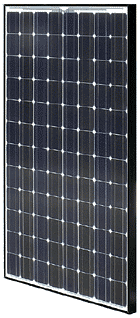Sanyo Panasonic 195 Watt Solar Panel HIT-195BA19
SKU HIT-195BA19- 195 Watt Peak Output
- Cell Efficiency: 19.3%
- Module Efficiency: 16.8%
- 5 Year Workmanship Warranty, 20 Year Power Output
- Monocrystalline cells for high-efficiency and uniform dark color.
- Perfect for high-power grid-tie and high-power battery charging using a MPPT charge controller.
Quantity discounts available!
For Home Grid-Tie Solar SystemsHigh
Efficiency Power Guarantee Temperature
Performance Proprietary
Technology Structural
Strength Valuable
Features Quality Products *HIT stands
for Heterojunction with Intrisic Thin Layer. Supported by the New
Energy and Industrial Technology Development Organization (NEDO)
in Japan. Specifications, product design, and information on this
website are subject to change without notice.
About HIT Technology The SANYO HIT (Heterojunction with Intrinsic Thin layer) solar cell is composed of a single thin crystalline silicon wafer surrounded by ultra-thin amorphous silicon layers. This product provides industry-leading performance and value using state-of-the-art manufacturing techniques. Crystalline
silicon solar cell and HIT solar cell structure comparison HIT solar cells improve boundary characteristics and reduce power generation losses by forming impurity-free i-type amorphous silicon layers between the crystalline base and p- and n-type amorphous silicon layers.
News Release SANYO Commences Operations at the New Shiga Factory for Solar Module Production Responding to expected growth in domestic market demand Tokyo, August 5, 2008 SANYO Electric Co., Ltd. (SANYO) announces that it has completed construction of the Shiga Plant at its Shiga facilities (Ohtsu City, Shiga Prefecture) which was constructed for the assembly of HIT solar cell modules as part of continuing plans to expand and develop its Solar business. The Shiga Plant will have an initial production capacity of 40 MW, and SANYO will consider expanding the production capacity of the factory upon further review of market trends and demand. SANYO currently produces HIT solar cells at two factories, at the Nishikinohama Factory (Kaizuka City, Osaka) and Shimane SANYO Electric Co. (Unnan City, Shimane Prefecture). The modules, or panels, are then assembled at two domestic facilities (Nishikinohama Factory and the Tokyo Plant) and two overseas facilities (Hungary and Monterrey (Mexico) Factories). With the new operation at the Shiga Plant which will be one of the major bases for module production, SANYO will respond to domestic market demands, including increases in demand in the future. Outline of the Solar Business Shiga Factory • Factory
address: 1-1-1, Seta, Ohtsu City, Shiga Prefecture
Sanyo's solar
division was established in 1976 in Carson, California. Since 1967 Solec solar electric modules have been used worldwide in urban and remote locations. From major metropolitan areas to small villages, Solec's cost effective modules work dependably and efficiently. In 1994, Solec combined forces with SANYO Electric, Japan. Both companies share a commitment to excellence and making strides toward improvements in the solar energy industry. These are exemplified by the numerous patents held by the companies and proprietary advances that have been made. Further, in our efforts to manufacture a superior product, Solec's modern equipment uses high quality materials. Solec was a pioneer in developing major improvements in crystalline silicon photovoltaic (PV) technology. Today many high-power PV applications utilize crystalline silicon single crystal cells and photovoltaic modules. In 1997, SANYO introduced a product called HIT Power 21™ (Heterojunction with Intrinsic Thin layer). This 21st century hybrid product combines the single crystalline cell with amorphous silicon. The result has been astounding. The HIT™ cells have the capability of achieving an incredible 20% efficiency rating in laboratory conditions. Solec continues to find ways to harness the energy of sun to provide alternative energy. Their goal is to preserve our environment by bringing the sun down to earth. |
||||||||||||






